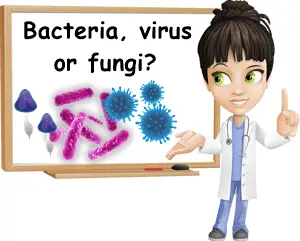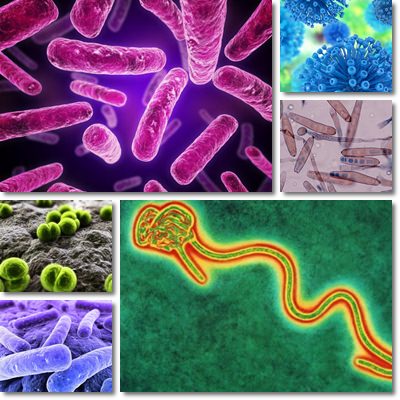We hear the terms bacterial, viral and fungal infection all the time, but what’s really the difference between bacteria, viruses and fungi? Believe it or not, all three are quite different organisms and not all produce infection and disease. For example, bacteria can be pathogenic, causing infection and disease, beneficial such as the good gut bacteria or neutral, producing neither disease nor providing any benefits. Fungi can be either beneficial such as those used to produce medicines or pathogenic like those causing athlete’s foot or skin mycosis, while viruses are for the most part a source of serious diseases from influenza to cancer. There are actually more differences and very few similarities between bacteria, viruses and fungi and the diseases they cause.
1) What are bacteria and what do they do?
Bacteria are essentially unicellular organisms, meaning they are made up of one cell. There are good bacteria like probiotics that help us digest food and make vitamins like vitamin K and vitamin B9. There are bacteria that simply live off of us without causing any harm or providing any benefits like some strains of Staphylococcus that are normally found on the skin. And then there are pathogenic bacteria that cause infection and disease, from gastritis and peptic ulcers to pneumonia and meningitis. Bacteria essentially live with us, among our cells.

2) What are viruses and what do they do?
Viruses are even smaller than bacteria and not even technically alive according to some researchers. They are considered particles with genetic material and produce disease by infecting our cells. Viruses spread by infiltrating healthy cells and using them to duplicate themselves until they become too many to deal with. Unlike bacteria which can live and multiply on surfaces, viruses need a host and require access to healthy, living cells to spread. Viruses can infect bacteria too. A big difference between bacteria and viruses is that bacteria respond to antibiotic treatment, while viruses don’t, hence the reason antibiotics are not prescribed for the flu or any viral infection. Viral infections are treated with antiviral medication.
3) What are fungi and what do they do?
Fungi are basically yeasts, molds and mushrooms. Unlike bacteria and viruses, fungi are either unicellular or multicellular, meaning they can be made up of one or more cells. Some fungi are beneficial such as the molds from which antibiotics are extracted. Others help ferment some of our favorite foods like bread, miso, tempeh, soy sauce or wine. Edible mushrooms like Portobello mushrooms, shiitake and oyster mushrooms are also fungi. Other fungi are toxic or can elicit severe allergic reactions. More important, some fungi produce compounds that suppress bacteria, virus and cancer cell growth. At the same time, some viruses can infect fungi.
There is also a fourth type of infectious agent, namely parasites.
4) What are parasites and what do they do?
Parasite is a name used to refer to any living being that lives off another, usually by producing some sort of damage or loss to its host. A great example of parasites is intestinal worms which live in the human gastrointestinal system. Intestinal worms eat our food and deprive us of essential nutrients in order for them to grow and multiply. Some even migrate from the gastrointestinal system, producing varied and sometimes irreparable tissue damage to the lungs, brain, muscles or eyes. Intestinal parasites may cause weight loss, anemia, fatigue, nausea, apathy or irritability as a result of the vitamin and mineral deficiencies they generate. However, not all parasites are harmful, some producing benefits for their host like the birds that eat leftovers from crocodiles teeth.

Bacteria, viruses and even fungi can be called parasites in the sense that they somehow take advantage of other organisms to live and replicate. But parasites in the literal sense of the word refer to organisms that actually live in a biological association with others and rely on those organisms to live, grow and multiply, then move onto another host. The difference between bacteria and parasites, for example, is that bacteria can grow and spread on a surface for example, whereas parasites typically require a host and resources provided by said host to do so.
Types of diseases they cause
Here are some of the main diseases caused by bacteria, viruses and fungi as well as parasites:
A) Bacteria: sore throat, strep throat, foodborne illness, tuberculosis, pneumonia, meningitis, gastritis, stomach ulcers, foodborne illness.
B) Viruses: the common cold (see article on The Common Cold: Causes, Symptoms and Treatment), the flu (see article on Influenza: Causes, Types, Symptoms and Treatment), cold sores, hepatitis, measles, HIV, AIDS, gastroenteritis (stomach flu), pneumonia, viral meningitis, cancer etc.
C) Fungi: fungal infections such as ringworm, skin mycosis, athlete’s foot, some forms of pneumonia etc.
D) Parasites: intestinal parasites infection, liver and bile duct cancers, head lice etc.
Main differences
Here are some interesting differences to consider between bacteria, viruses and fungi:
1) Viruses are actually smaller than bacteria and both are smaller than a lot of fungi.
2) Bacteria and fungi are living organisms, while viruses are not technically alive. Viruses can only replicate inside the cells of a living being, but not on their own. They are merely a collection of genetic material which, according to the scientific community, does not meet the criteria for ‘living organism’.
3) Bacteria live among cells, viruses inside cells while fungi can live both in cells and between them, inside the body or outside.
4) Bacterial infections are treated with antibiotics. Viral infections respond to antivirals. Fungal infections are treated with antifungal medication, while parasitic infections are treated with antiparasitic (anthelmintic) medication.
5) Viruses can enter the body through the nose, mouth and eyes. Bacteria can enter the body through the respiratory system but also cuts, injuries or produce infection on the surface of the skin. Fungi often produce infection outside the body. Parasites can produce infection both inside the body such as intestinal parasites or outside such as head lice.
6) There are good and bad bacteria, viruses that cause disease and viruses that are dormant in the body, without producing infection for years. Out of all the fungi that infect humans, all are pathogenic, meaning they produce disease.
7) Viruses can infect bacteria and fungi, but not the other way around. Some fungi produce compounds that can inhibit the growth of certain bacteria, viruses and even cancer cells.
